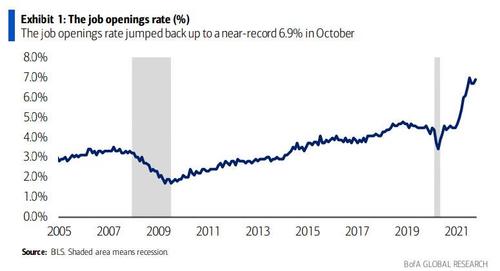The US Is Now At Full Employment
Despite last Friday’s mixed unemployment report which saw a huge miss in payrolls but also indicated that the US unemployment rate had tumbled to just 4.2% (below the lowest estimate) from 4.6%, it remains well above the pre-covid levels in the very low 3%-range. However, according to Bank of America Chief Executive Officer Brian Moynihan, this may be as good as it gets. Speaking in a wide-ranging interview with Bloomberg Television, Moynihan said that the U.S. economy is now at full employment, adding that supply-chain problems are beginning to normalize slowly. We agree with the former, and disagree with the latter. The CEO also said that inflation is “no longer up for debate” in the U.S., and reining in the problem will be “hard work.”
We will, for now, ignore his comment on raging inflation “no longer being up for debate”, although we will remind readers how extensively we were “debating” the ridiculous argument that inflation is transitory for all of 2021 while the rest of the experts stubbornly took the other side (they are oddly quiet now), and instead focus on his claim that the US is now at full-employment, which if true, would mean that inflation could spike even faster from here due to the lack of slack in the labor force, not to mention have wide-ranging political implications for an administration which is still in its first year and has precious few other economic achievements to point to.
Addressing this critical issue, in his daily note titled “Hitting full employment” published earlier today, BofA’s chief economist Ethan Harris writes that one of the striking things when talking to business leaders is the ubiquitous shortage of workers: “virtually every part of the country and every industry is experiencing labor shortages” and the macro data certainly confirm the complaints. After a one-month dip, the job openings rate jumped back up to a near-record 6.9% in October.
Some more data: in the November employment report, the labor force jumped by 594k, but that was more than matched by a 1,136k jump in household employment. Business surveys, the Fed’s beige book and other anecdotal evidence show a persistently tight labor market.
Some forecasters, including the Fed, hope that a surge in the labor supply will bring relief. However, most forecasts—the Fed’s, the Bloomberg consensus and BofA’s own — assume that labor demand will continue to outgrow labor supply translating into chronically higher wages and the potential dreaded wage-price spiral.
As Harris further notes, by the end of next year, the median forecast of both the Fed and the Bloomberg consensus has the unemployment rate falling to 3.8%. However, that number is almost certainly stale given the surprising plunge from 4.6% to 4.2% in the November employment survey last week.
So could a bigger jump in the labor supply save the US from the shortages? Well, Harris – like Moynihan – doubts it, and there are many reasons to expect only a partial rebound in the supply of workers:
- The Covid crisis has many people rethinking their priorities. BofA estimates that as of 3Q ’21, early retirements and caregiving responsibilities had each caused at least a 1 million drop in the labor force.
- The resistance to vaccines and mask rules along with a steady diet of Covid news has convinced many workers that going back to the labor market is too risky, according to Harris
- Ironically, the BofA economist also notes that vaccine mandates have encouraged anti-vaxxers to also leave the labor market (albeit in smaller numbers).
- Covid has resulted in about 197k deaths of working-age people and has left many with long-run health problems.
Most amusingly, BofA notes that “since the beginning of the crisis households have accumulated $31tr in net worth, including almost $4tr in liquid deposits, allowing them to avoid working.” Which of course, is completely false because as we showed earlier, most if not all of the “net worth” has been accumulated by the 1%, with virtually nothing going to the bottom 50%… as in those who actually have to work.
So no, the wealth accumulation is not what is allow Americans to retire en masse. But still, BofA is right – the US has hit full employment, and the bottom line is that a good chunk of the labor shortage is likely here to stay which will have profound implications for wage inflation and monetary policy in the years to come, especially since what the Fed really wants – contrary to its stated intentions – is to inflate away the debt and to spark just the kind of wage-price spiral it claims it is hoping to avoid. After all, something has to inflate away all those trillions in debt.
Tyler Durden
Fri, 12/10/2021 – 07:00
Zero Hedge’s mission is to widen the scope of financial, economic and political information available to the professional investing public, to skeptically examine and, where necessary, attack the flaccid institution that financial journalism has become, to liberate oppressed knowledge, to provide analysis uninhibited by political constraint and to facilitate information’s unending quest for freedom. Visit https://www.zerohedge.com


